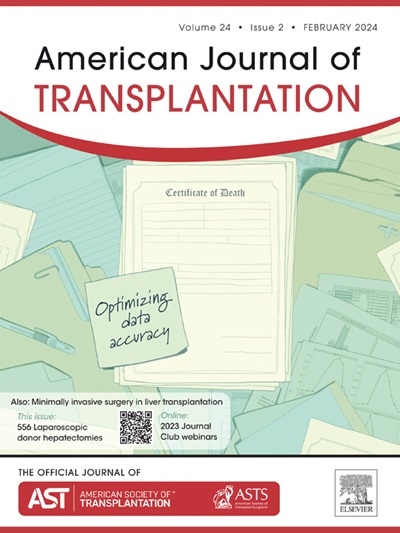Potential targeting of urokinase-type plasminogen activator receptor–formyl peptide receptor signaling to prevent recurrence in posttransplant primary podocytopathies
IF 8.2
2区 医学
Q1 SURGERY
引用次数: 0
Abstract
Primary podocytopathies are a group of disorders characterized by nephrotic syndrome and frequent progression to kidney failure, with high rates of posttransplant recurrence. Increased expression of the urokinase-type plasminogen activator receptor (uPAR) has been associated with podocyte dysfunction in primary podocytopathies. uPAR can interact with formyl peptide receptors (FPRs) in podocytes, but the relevance of this signaling pathway in these diseases remains unclear. We retrospectively evaluated uPAR-FPR expression in renal biopsies from patients with primary podocytopathies with recurrent disease after transplantation. Upregulation of uPAR-FPR signaling was consistently observed in podocytes from kidney biopsies of patients with primary podocytopathies and in cultured podocytes exposed to sera from patients with recurrent disease. Pharmacologic inhibition of uPAR-FPR interactions with UPARANT restored podocyte plasticity, reversing cytoskeletal alterations and protecting against damage. This treatment also led to significant functional recovery in an in vitro glomerular filtration barrier model. Finally, targeting uPAR-FPR crosstalk in a zebrafish model of podocytopathy reversed podocyte foot process effacement and reduced glomerular loss of high-molecular weight dextran, effectively alleviating the disease phenotype. Our data indicate that pharmacologic targeting of the uPAR-FPR axis protects podocytes from damage and may preserve renal function in primary podocytopathies, potentially reducing recurrence after transplantation.
潜在靶向uPAR-FPR信号预防移植后原发性足细胞病变复发
原发性足细胞病是一组以肾病综合征为特征的疾病,经常进展为肾衰竭,移植后复发率高。尿激酶型纤溶酶原激活物受体(uPAR)的表达增加与原发性足细胞病变的足细胞功能障碍有关。uPAR可以与足细胞中的甲酰基肽受体(fpr)相互作用,但这种信号通路在这些疾病中的相关性尚不清楚。我们回顾性地评估了移植后复发性足细胞病变患者肾活检中uPAR-FPR的表达。在原发性足细胞病变患者肾活检的足细胞和暴露于复发性疾病患者血清的培养足细胞中,一致观察到uPAR-FPR信号的上调。药理抑制uparr - fpr与UPARANT的相互作用可恢复足细胞的可塑性,逆转细胞骨架的改变,并保护其免受损伤。在体外肾小球滤过屏障模型中,这种治疗也导致了显著的功能恢复。最后,在斑马鱼足细胞病模型中靶向uPAR-FPR串扰可逆转足细胞足突消退,减少肾小球中高分子量葡聚糖的损失,有效缓解疾病表型。我们的数据表明,药物靶向uPAR-FPR轴可以保护足细胞免受损伤,并可能保护原发性足细胞病变患者的肾功能,潜在地减少移植后的复发。
本文章由计算机程序翻译,如有差异,请以英文原文为准。
求助全文
约1分钟内获得全文
求助全文
来源期刊
CiteScore
18.70
自引率
4.50%
发文量
346
审稿时长
26 days
期刊介绍:
The American Journal of Transplantation is a leading journal in the field of transplantation. It serves as a forum for debate and reassessment, an agent of change, and a major platform for promoting understanding, improving results, and advancing science. Published monthly, it provides an essential resource for researchers and clinicians worldwide.
The journal publishes original articles, case reports, invited reviews, letters to the editor, critical reviews, news features, consensus documents, and guidelines over 12 issues a year. It covers all major subject areas in transplantation, including thoracic (heart, lung), abdominal (kidney, liver, pancreas, islets), tissue and stem cell transplantation, organ and tissue donation and preservation, tissue injury, repair, inflammation, and aging, histocompatibility, drugs and pharmacology, graft survival, and prevention of graft dysfunction and failure. It also explores ethical and social issues in the field.

 求助内容:
求助内容: 应助结果提醒方式:
应助结果提醒方式:


